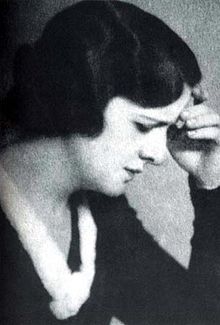Latife Uşaki
Latife Uşakizâde | |
|---|---|
 | |
| First Lady of Turkey | |
| In office October 29, 1923 – August 5, 1925 | |
| Succeeded by | Mevhibe İnönü |
| Personal details | |
| Born | Latife Uşakizâde June 17, 1898 Smyrna, Ottoman Empire |
| Died | July 12, 1975 (aged 77) Istanbul, Turkey |
| Nationality | Turkish |
| Spouse | Mustafa Kemal Atatürk (1923 - 1925) |
| Residence | Çankaya Köşkü (official) |
| Alma mater | University of Paris Law school in London |
| Profession | Jurist |
Latife Uşakizâde (later Latife Uşaklıgil after the Surname Law of 1934; with the honorifics, Latife Hanım)[1] (June 17, 1898 – July 12, 1975) was Mustafa Kemal Pasha's (later Atatürk) wife between 1923 and 1925. She was related from her father's side to Turkish novelist Halit Ziya Uşaklıgil.
She was born in 1898 in İzmir to one of the most prominent trading families of the city, with roots in the city of Uşak, whence their unofficial family name of Uşakizâde. She completed her high school studies in İzmir and in 1919 she went abroad to study Law in Paris and London. When she came back to Turkey, the Turkish War of Independence was nearing its end.
On September 11, 1922, upon returning to her family mansion in Izmir, she was confronted by soldiers who notified her that the Pasha had taken the house as General Headquarters in Izmir. After convincing the soldiers that she actually belonged to the household, she was allowed in.
They married on January 29, 1923, when Mustafa Kemal Pasha had returned to İzmir just after his mother Zübeyde Hanım's death. For two and a half years, Lâtife Hanım symbolized the new face of Turkish women as a first lady who was very present in public life which, in Turkey, was a novelty by the standards of her day. She was a very important theme in the reforms which began in Turkey in the 1920s for the emancipation of women. No doubt influenced by her husband's staunch secularism, she discarded her Islamic head covering and urged Turkish women to do the same.[2]
However, the relationship between her and her husband was cut short after the summer of 1925. They divorced on August 5, 1925. Lâtife Hanım lived the rest of her days in İzmir and İstanbul, in virtual seclusion, avoiding contacts outside her private circle until her death in 1975. She never remarried, and remained silent about their relationship throughout her life. As late as 2005, her family has rejected proposals to make her diary and letters public.[3]
A comprehensive but also controversial biography of Latife Hanım by the veteran Cumhuriyet journalist İpek Çalışlar was published in 2006.[2]
Gallery
-
Latife Uşakizâde in 1923.
-
Mustafa Kemal Atatürk and Latife Uşakizâde, during a trip in 1923.
-
Mustafa Kemal Pasha and Latife Hanım (far right) with her family in early 1923.
-
Mustafa Kemal Pasha and Latife Hanım.
-
Atatürk and Latife Uşşaki
References
- ^ "Turkey in the 21st century: The Legacy Of Mrs Ataturk". Pelin Turgut. The Independent. 1 July 2006. Retrieved 2007-09-29.
- ^ a b "Atatürk, his wife and her biographer". Emrah Güler. Turkish Daily News. 25 August 2006. Retrieved 2007-09-29.
- ^ "Ataturk diaries to remain secret". BBC. 4 February 2005. Retrieved 2007-09-29.
- İpek Çalışlar (2006). Latife Hanım ISBN 978-975-991-517-9 (in Turkish). Doğan Kitap.






